The Song of Ice and Fire on the Chain
"The dead will never die, they will rise again, and their power will be even stronger!"
- The Song of Ice and Fire
This article comprehensively reviews the complete development process of the Loot ecosystem from rise to decline, and then to recovery, with detailed data.
Authors: @TianranZhang, @fangtingeth, @_eat_apple_, @0xBrawler
Source: @AW_Research
The Song of Ice and Fire on the Chain
"The dead will never die, they will rise again, and their power will be even stronger!"
- The Song of Ice and Fire
In just two short years since its birth, Loot has interpreted a chain version of "The Song of Ice and Fire." During the initial frenzy, nearly 300 derivative projects formed a Lootverse. After the cooling off, the Lootverse community receded, leaving a core group of truly passionate creators who, at very low cost, preserved the spark of the story and weathered crises such as Luna and FTX. Time has proven that a good story never dies: in the early spring of the metaverse, dojo reignited the spark of Loot, and derivative projects in the Lootverse regained vitality, with a significant increase in both quantity and quality of creations.
As the severe cold has passed, on the eve of the revival of Lootverse, we will reread this "Eternal Story." This article will cover the following three aspects: the origin of Lootverse; the evolution of Lootverse IP and ecosystem; why Lootverse is the best existing story in the entire chain.
The Origin of Lootverse
Two years ago today, on August 28, 2021, Lootverse was born. Within ten days, the price of Loot soared to a peak of 20e at an astonishing speed. Behind the price was a series of value propositions within the "crypto native" standard, such as Lootverse being built from the bottom up, a decentralized team, and the use of "txt NFT" instead of rich media NFT. A few lines of white text on a black background formed a "prompt" for a complete world system, allowing everyone to find their own imagination of a "composable world" through those few columns of nouns, and not just imagine: Lootverse was completely open in its mechanics, allowing everyone to participate in the process of "collaboratively building the world" in substance.
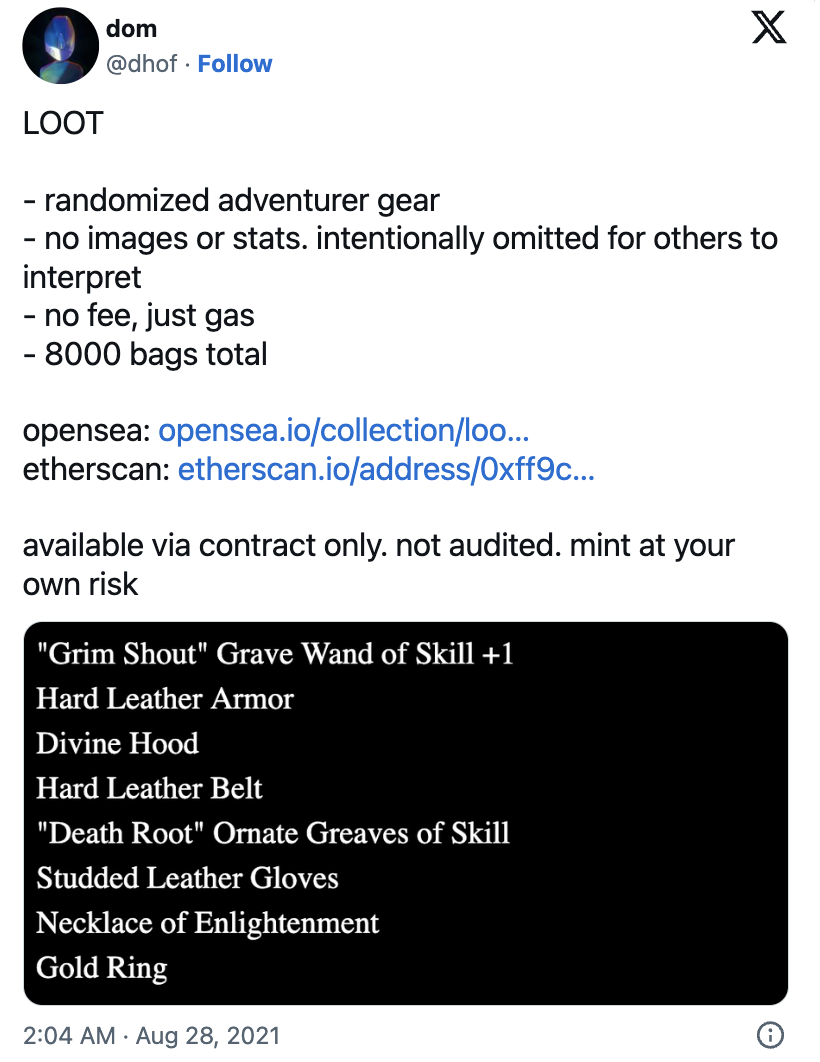
Early History: Concentrated Rise of Derivative Projects
An entirely open story universe combined with a freely tradable market resulted in an extremely prosperous group of derivative projects. Within three months, nearly 300 derivative projects emerged in Lootverse. Although most of them were speculative works, many original works also appeared.
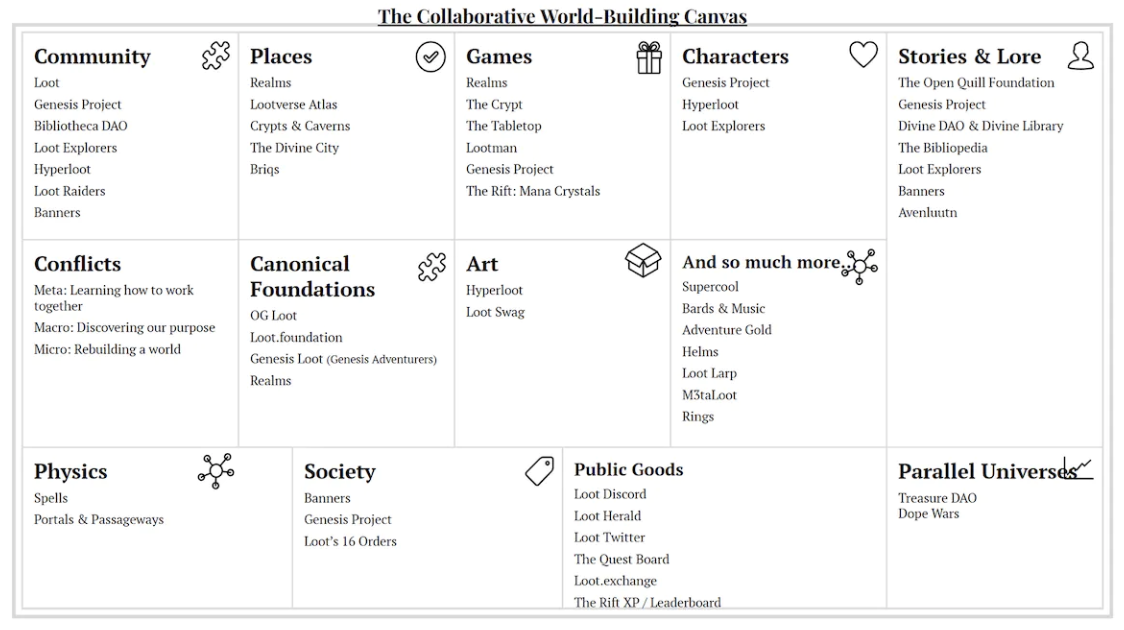
The Genesis Project initiated by Timshel (also the creator of Loot.foundation) was one of the important derivative projects. It reorganized the native Loot bag based on the suffixes of Loot, allowing holders to extract Genesis Mana and awaken Genesis Adventurers. This card collection and identity upgrade game cleverly mobilized the community, requiring collaborative communication among community members, and also drove everyone to have more creativity and familiarity with the meta timeline of Loot. The timeline organization of DivineDAO was also completed at this time. In this newly developed narrative context, there were a total of 2540 Genesis Adventurers NFTs, and naming rights were open.
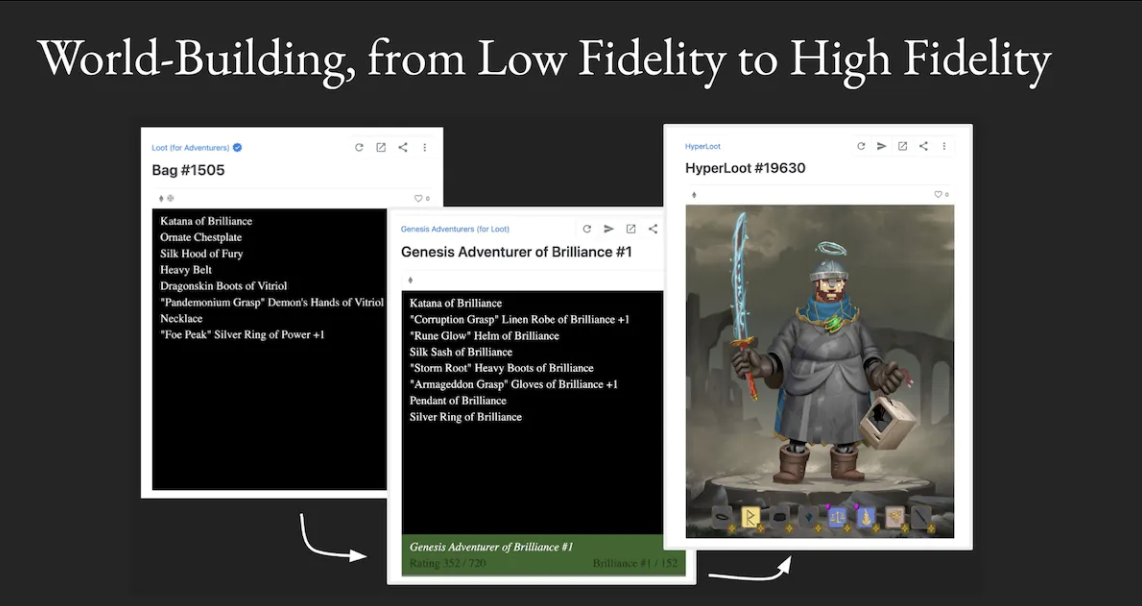
Genesis Adventurer and Hyperloot game screenshots
The open naming allowed GA to have the potential of "universal IP," allowing a character to be named Ned Stark or Jon Snow, creating true character prototypes in the Lootverse. Subsequently, the Genesis Scroll's story writing contest attracted considerable attention, piecing together the "Song of Ice and Fire" in the Lootverse. Dylan Field, the founder of Figma, was one of the earliest contributors to the Genesis Scroll project.

Hyperloot is a derivative project of Loot, presented visually from an artistic perspective, contributed by an excellent team from Thailand, with an excellent roadmap and product quality. It is connected to other Loot ecosystems (such as mloot, Genesis Project, etc.) and CC0 projects like Nouns, Chain Runner, and Blitmap. With the release of 3D NFTs in 2023 and its own branching game, Hyperloot is still worth paying attention to. Even Fred Ehrsam, co-founder of Paradigm and Coinbase, made great efforts to depict the efforts of the Hyperloot team in the CC0 war, similar to "Marvel Heroes VS Capcom."
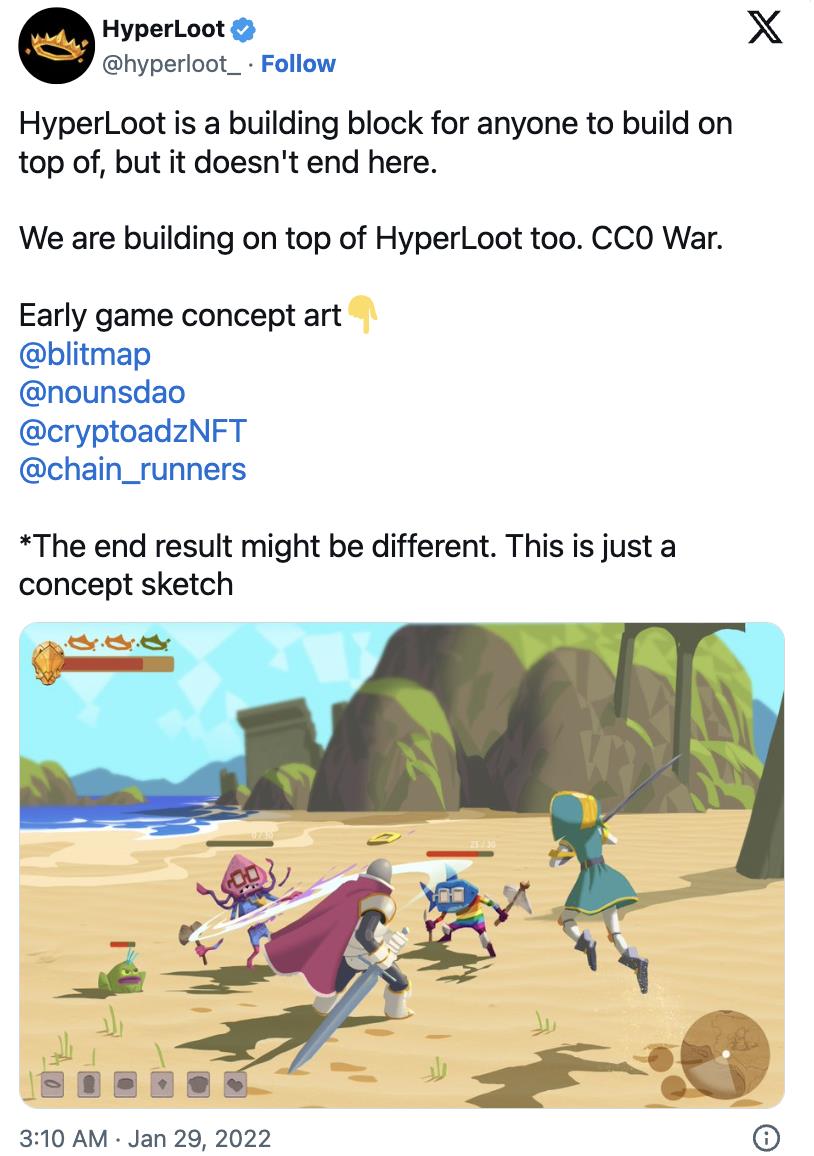
Crypts & Caverns is another important on-chain infrastructure in the Lootverse, created by threepwave in November 2021, providing composable dungeon maps. As a universal map, Crypts & Caverns is not only available within Lootverse, but will also be transferred to CheDAO for management in 2023. For information about CheDAO management, please refer to "Crypts and Caverns: A Sleeping Giant Awakened by CheDAO".
The Crypt is a dungeon exploration game based on Loot, aimed at obtaining imprisoned NFT relics. Players need to hold Loot, mLoot, or GA to participate in the game, which has three open chapters. This is the first fully playable on-chain Loot game. After the Playmint team received $4 million in funding, they began to build their own on-chain game.
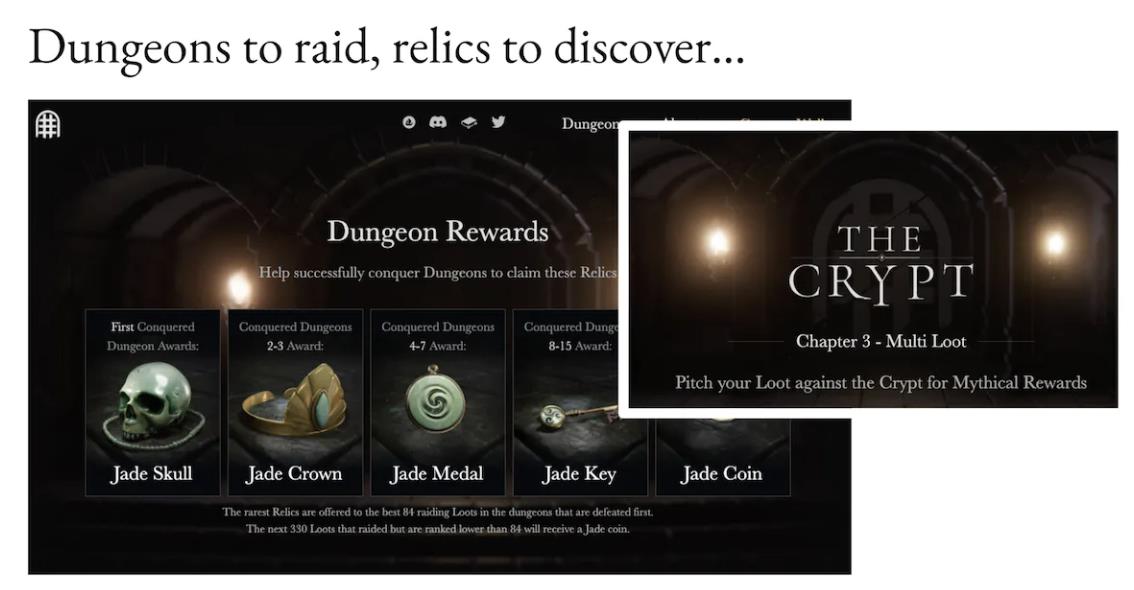
Adventure rewards in The Crypt game
Loot Realms is a series of 8000 programmatically generated NFTs developed by BibliothecaDAO. Realms is one of the core organizations in the Loot ecosystem, maintaining stable productivity, and subsequently released its governance token $LORD by staking Realm NFTs. Unlike other games, it chose Starknet as the destination for its game landing. The first game that Realms decided to build is a strategy SLG game called Eternum. More on this will be discussed later, as Realm has proven to be the sole pillar of Lootverse today.
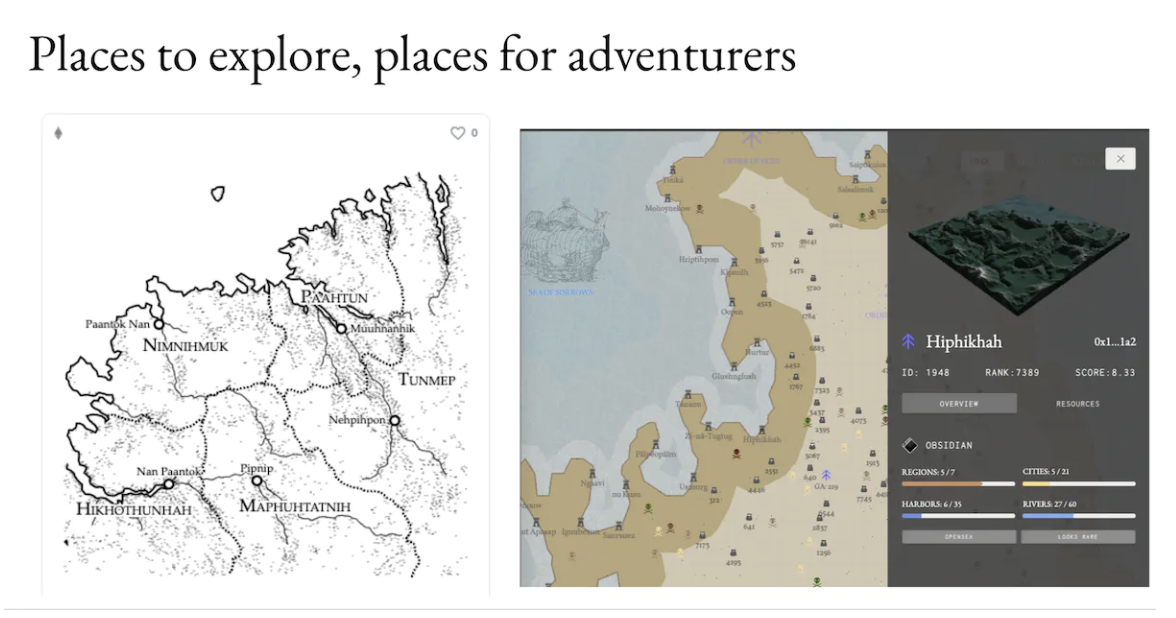
Realm NFT and early Realm: Eternum game screen
Dope Wars is a fully StarkNet-based on-chain Loot-style game, initiated by perama in August 2021, and flourished with contributions from the Cartridge team. Inspired by "Drug War" and "GTA," it integrates street culture into a "GTA"-style universe. The game's first playable mode "Roll Your Own" adapted "Drug War" to StarkNet's L2. As an important derivative project of Loot, "Dope Wars" and "Loot Realms" started on the Ethereum mainnet on August 31, 2021, and distributed 125,000 $PAPER tokens to NFT holders on September 4. The Cartridge team is currently developing Dojo, the StarkNet on-chain game engine, which will be introduced in the second half of the article.
Community Ecosystem Grant Program Driving in 2022
By the end of 2022, the community ecosystem of Lootverse was still thriving under the contributions of its core creators, hosting more than 30 community meetings; the milestone Loot Deck released by Timshel in April 2022 is still echoing in the community and is practically serving as the "North Star" of Lootverse.
The initial frenzy has cooled off, and within the first 3 months, an estimated 300 Lootverse derivative projects were created, with most of them quickly disappearing. However, about 10% of genuine projects still exist and new projects continued to emerge throughout 2022. By mid-2022, there were approximately 30 projects, most of which relied on self-funding or grants.
From the eight lines of white text on a black background to an interconnected network of projects, these projects together form an infinitely expandable yet cohesive science fiction and fantasy universe, driving the development of Lootverse.
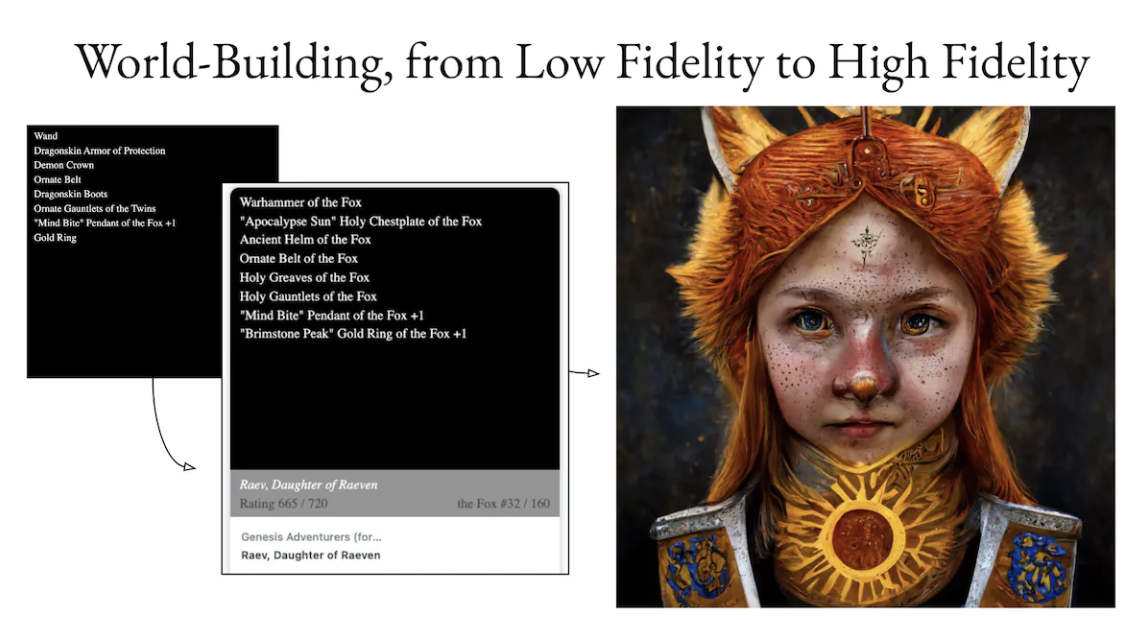
Artifacts created specifically for GA on the right
Gitcoin has been nurturing stable partners for Lootverse through regular funding opportunities. In rounds 14 and 15 of grants in June and September 2022, Gitcoin provided over $200,000 in total funding for the Loot ecosystem. Round 14 included support for projects such as "Monsters of Realms," "The Violette of Vitriol," "Genesis Scrolls," and "The Genesis Scrolls Painted." In September 2022, Gitcoin's round 15 grants provided $75,000 in funding for 21 projects to expand the Loot ecosystem. With a total of 1162 contributors contributing a total of $92,000, the total funding exceeded $84,000, providing timely support for a broader NFT interest decline.
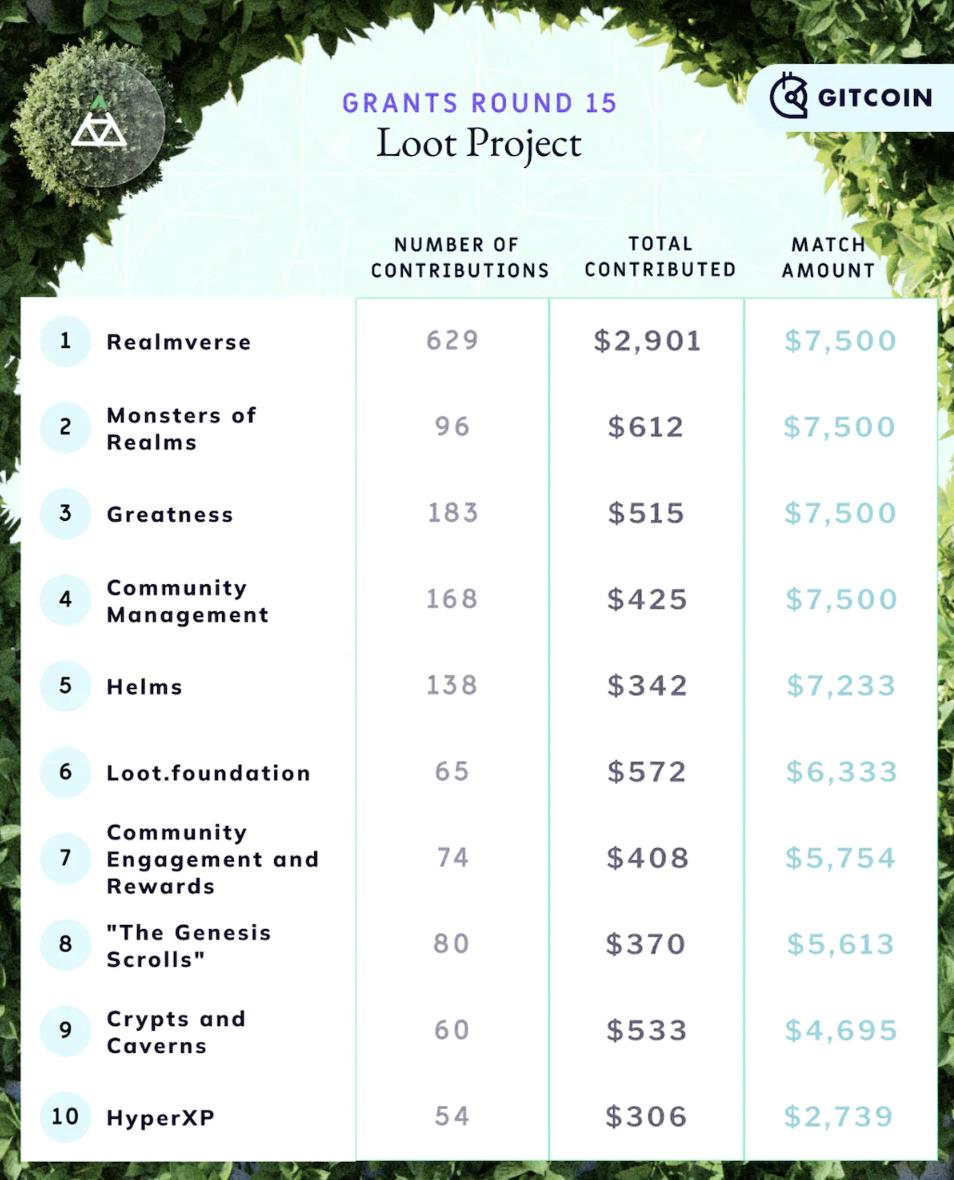
Lootverse ecosystem projects in Gitcoin's round 15
Mask Network also increased its support for Lootverse, supporting five key projects. In their first round of grants in November 2022, beneficiaries such as Genesis Scrolls and The Rift received $10,000 each to advance narrative and game infrastructure. In the second round of grants in June 2023, Dojo received $20,000 to further develop its StarkNet game engine, Guildly received $10,000 for NFT guild functionality, and Banners received $10,000 to transition its text RPG to the chain.
The strategic grants provided by Gitcoin and Mask at critical moments collectively demonstrate their commitment to maintaining the community-driven ecosystem of Lootverse. This funding helped projects overcome market fluctuations during the crypto winter and continue to build.
One significant grant is the Genesis Scrolls project, which was used to attract writers to bring Lootverse into real life, attracting nearly 100 entries in less than 6 months, totaling approximately 100,000 words. Subsequently, a professional editor was brought in to transform these works into a complete Loot book, expected to be published soon.
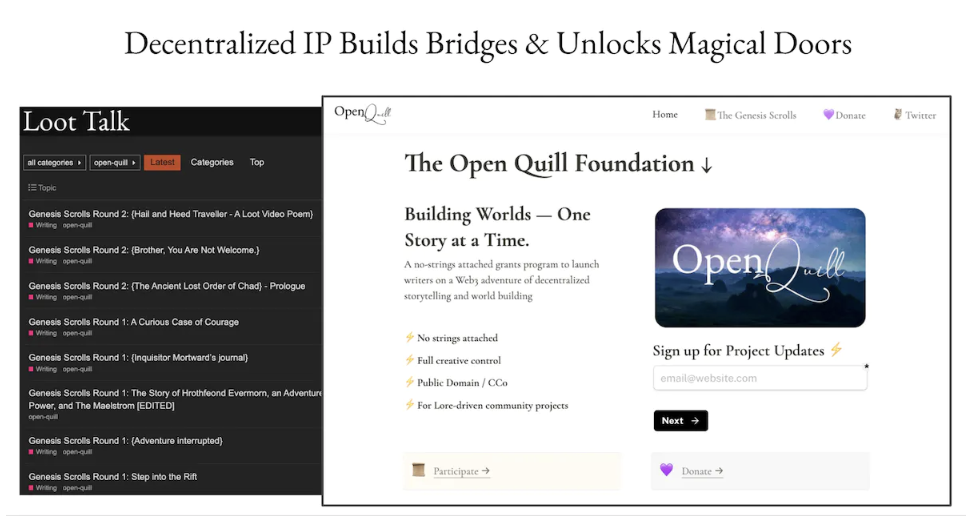
You can also check out this article to learn about the situation one year after Loot's birth.
Loot, One Year Later: The NFT Hype Is Dead—But 'Lootverse' Hope Lives On - Decrypt
Realms - The Culmination of Games
If Timshel's Genesis Adventurer and Genesis Scroll are the projects that link Lootverse together at the legendary level, then Loaf's Realm is uniting Lootverse through products, especially a set of games.
Before the game was released, on February 21, 2022, Realm showcased the first version of Realm Atlas, designed to showcase the upcoming content, which was stunning.
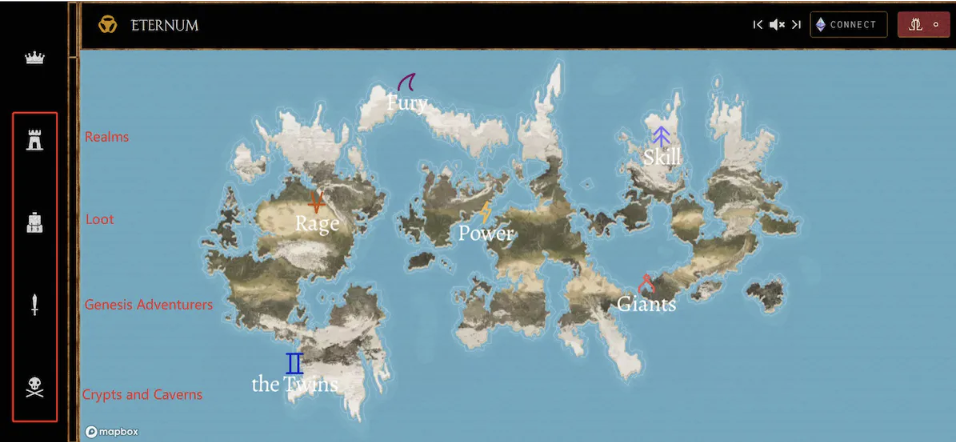
The Realm Atlas
This image shows the Atlas (world map) with 16 orders (countries) such as FOX, Power, and Giants, all generated based on Loot data. It is similar to the intricate political landscape in "Game of Thrones." NFT projects like Realms, Loot, Genesis Adventurers, Crypts, and Caverns are echoed in the Atlas with these countries.
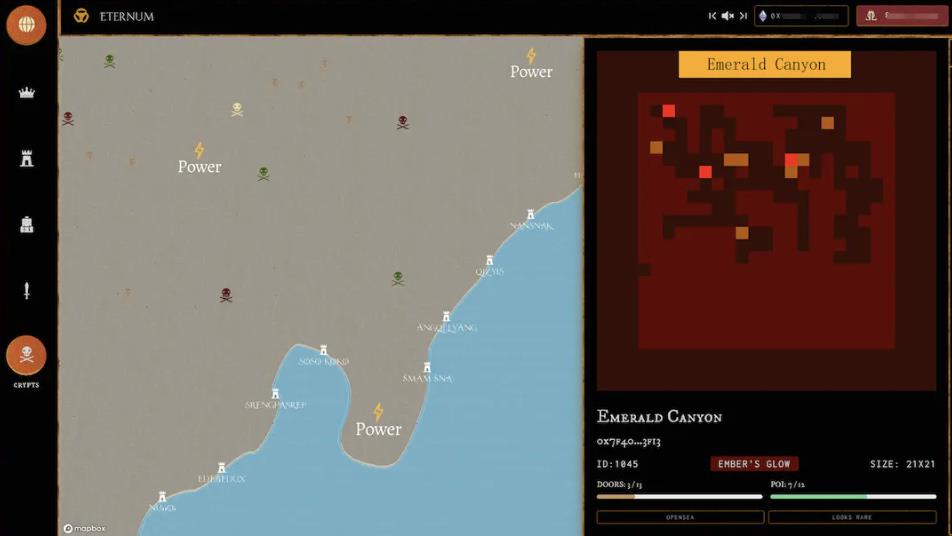
C&C in the Atlas, each skull represents a C&C block
Later, the Atlas evolved several times, adding features such as viewing your main four NFT packs, flying to your territory, and more. It also provided much-needed solace during the long wait for the main game Realm: Eternum.
The pre-alpha version of Realm: Eternum was released in January 2023, presenting a complete experience where players can exchange resources, build armies, construct castles, and wage wars. The game is still rough in some aspects, but the gameplay already exists.
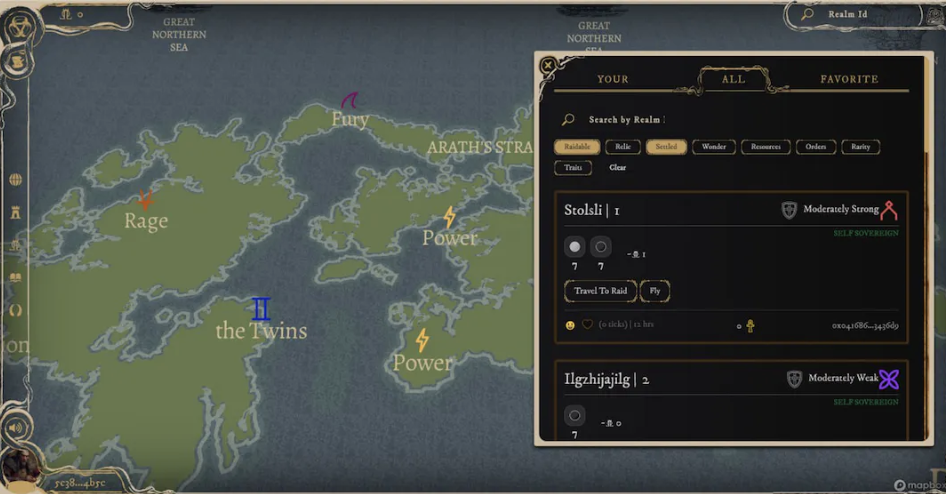
First version of Realm Eternum
A few days after the pre-alpha version was released, the Realms team launched a $625,000 funding round for the community. With $4,000,000 committed within 24 hours, the oversubscription rate reached an astonishing 6.32 times (5.32 times refunded), reflecting the community's strong confidence in Realms' growth.
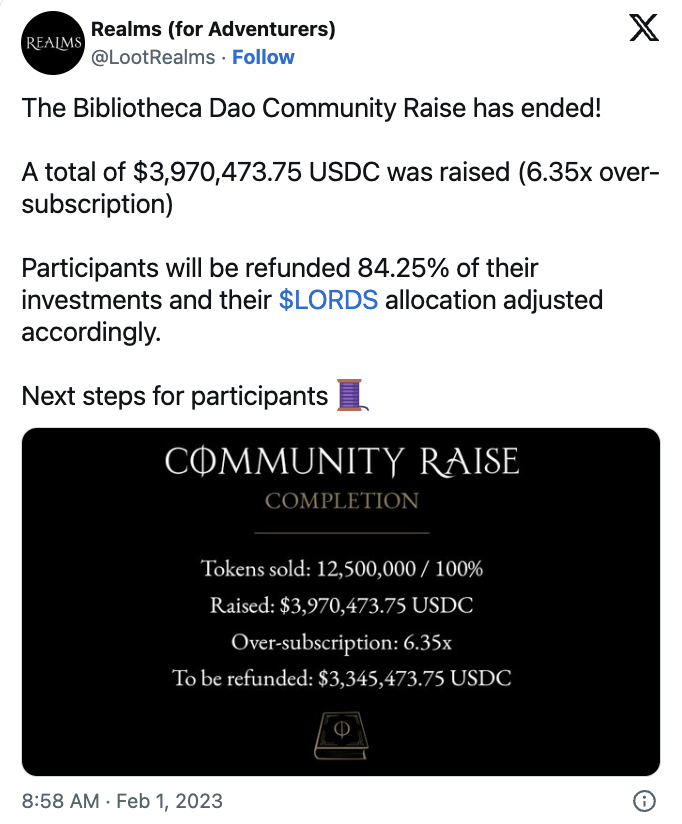
However, for most community projects, surviving the depths of the crypto bear market became difficult due to a series of market crashes and other reasons. By the spring of 2023, only 5 out of approximately 30 Lootverse projects remained active. Nevertheless, spring is on the horizon.
Entering the Era of DOJO - Cairo's On-Chain Game Engine
Building games directly on the blockchain is a huge challenge, as pioneers like Dark Forest and Realm Eternum have discovered. The test of the first version of Realms: Eternum clearly showed two things. First, a dedicated game framework or engine is needed to facilitate game development. Second, a simpler game is needed to enrich the domain world and enter the market faster. The first requirement confirmed the significance of Dojo, while the second requirement drove us towards Loot survivor.
Thanks to the Lattice team creating MUD in early 2022, the problem was eventually solved, and the concept of autonomous worlds was later introduced, all of which were hugely successful. Dojo initially started from a Telegram group composed of members from the realm, cartridge, and briq teams. It was initially created on StarkNet in November 2022 as a branch of MUD v1. With the allocation of development resources, Dojo has far exceeded the initial concept.
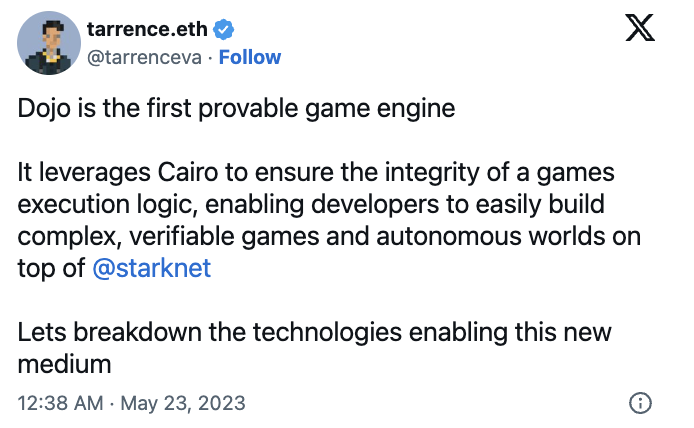
Dojo Engine is a public game engine built by Starknet developers. It is the only verifiable game engine on the market, and verifiability has largely inspired the architecture and tools built for the game engine.
Dojo provides developers with an Entity-Component-System (ECS) architecture and integrated tools tailored for Starknet and Cairo development. This open-source engine lowers the barrier to creating high-quality on-chain games with true ownership and asset interoperability. By fostering a strong community, Dojo aims to drive innovation, surpassing the achievements of MUD on EVM.
Loot Survivor is a text-based adventure game created by Bibliotheca DAO on Starknet. It leverages the procedural generation elements of Loot, allowing players to adventure in dangerous domains filled with monsters, traps, and bosses. The goal is to rank high on the leaderboard before your character perishes.
This game cleverly implements the Play2Die economic model, carrying and dropping tokens upon character death, compensating early adopters and incentivizing participation. Over 500 on-chain characters have been created.
Loot Survivor showcases creative on-chain game design and community engagement. It is built on Cairo on StarkNet, maintaining low gas costs while remaining completely on-chain. Although the current interaction speed is slow, Ethereum improvements like EIP-4844 will enhance StarkNet's performance and reduce the cost of on-chain games.
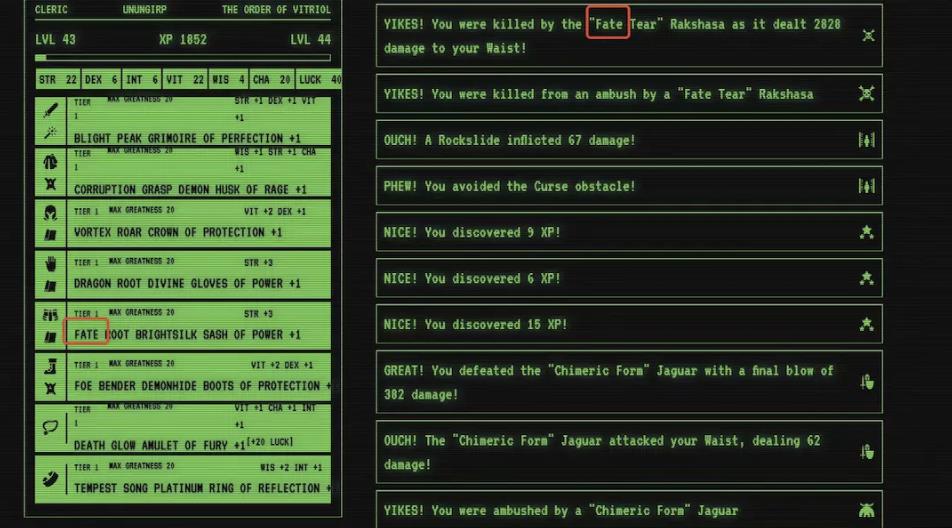
Loot survivor items at level 20
It is also worth noting that the item and number design of the "Loot Survivor" game is in line with the initial Loot and GA settings, as the design of this game is led by Loothero. This good inheritance brings back memories for loyal Loot fans, allowing them to revisit the early Loot frenzy in the later stages of "Loot Survivor." Sacred robes, katanas, +1 attributes, 16 orders, you name it.
The Rise of Dojo and Loot Survivor: Realms Members and Starknet On-Chain Game Team Forge Ahead
The on-chain game summit held in Portugal on May 25th to 26th marked a milestone for the Loot and Dojo ecosystems. Among the 50 participants at the summit, 6 came from Realm, 4 from Cartridge, and 2 from briq, accounting for a quarter of the attendees. In the three days before the summit, Tarrence's announcement about Dojo garnered widespread attention and recognition in the Starknet and Ethereum communities. Polynya stated that the infrastructure created for on-chain games will usher in a new paradigm and lead to broader application layer innovation. The demonstration of Dojo on the first day of the summit was successful and received strong community support. On the second day, during the designated game testing period, Loot Survivor made its first appearance from the internal alpha version, which happened to be the only playable game at the time. Despite the poor performance of Starknet, operations in the game took 3 minutes, but the leaderboard system motivated those eager to win to climb the rankings, and the bounty constantly updated as people quickly broke each other's records, eventually reaching a bounty of 0.1 ETH. This mechanism has proven to be successful.
As Dojo's technical infrastructure matures, more and more games are starting to appear on Dojo. (The first version of Loot Survivor was built directly on StarNet, not on Dojo. Two hackathons were held in June and July, with pixellaw becoming a great addition to the Dojo family. Initially, this was just a brainstorm at the Komorebi Hacker House in Paris.
Dojo and Loot Survivor have become key initiatives in the Loot ecosystem. They highlight the potential of StarkNet in delivering on-chain gaming experiences.
Early games such as Influence, Dope Wars, and Realms showcased the potential of Dojo. As the first game engine designed from scratch for StarkNet, Dojo lays the foundation for the next generation of crypto games. Its open and scalable nature will allow the engine to evolve continuously as StarkNet matures. Dojo represents a key milestone in delivering on the promise of blockchain gaming.
The Rebirth of Crypts and Caverns
Crypts and Caverns (C&C), a groundbreaking procedurally generated map NFT project, has recently been acquired by CheDAO, marking an exciting new era for C&C. C&C has demonstrated its adaptable generation mapping capabilities and has tremendous potential. However, progress has stagnated in recent times. With CheDAO taking over C&C, new momentum and scalability are expected to emerge.
CheDAO plans to optimize C&C as flexible mapping modules for developers. Through partnerships, the goal is to drive the adoption of C&C as the standard for random maps in on-chain games. This is intended to make C&C widely used in games that require procedural environments.
C&C is ready to fully realize its tremendous potential, showcasing its versatility through integration with various games, including Lootverse, and will continue to focus on community engagement. C&C injects a bright future into the innovation of community-driven on-chain games. The progress of integration across game universes will demonstrate the adaptability of C&C's generation mapping capabilities.
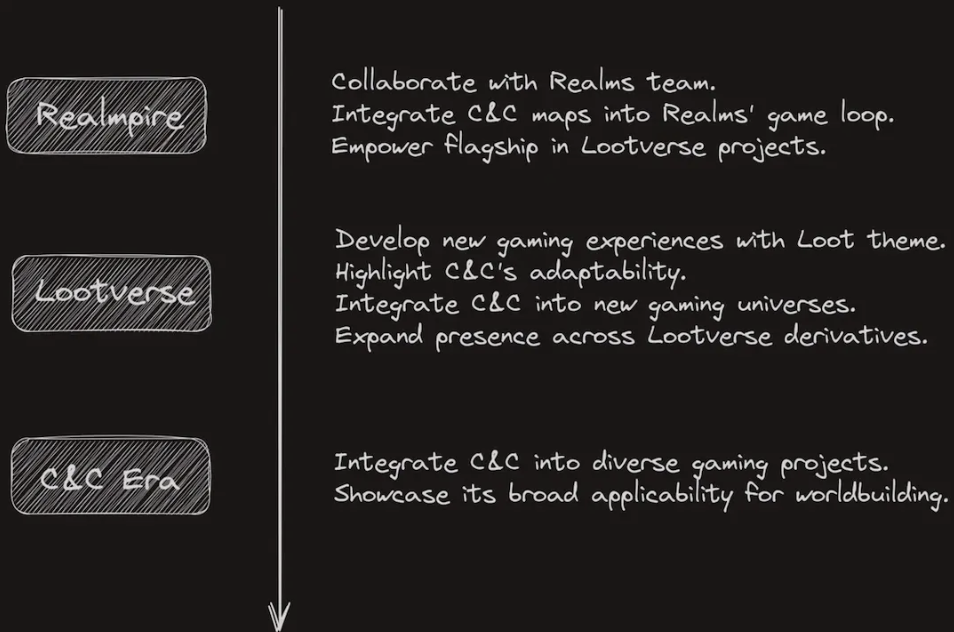
Crypts & Caverns' new roadmap
Frontinus House: A Grant Distribution Platform
Realms Autonomous World (RAW) aspires to truly live up to its name: autonomous. However, this autonomy depends on the existence of infrastructure, often referred to as public goods. This understanding gave rise to the concept of Frontinus House, a way to deploy capital internally in RAW and the broader Loot ecosystem to fund projects.
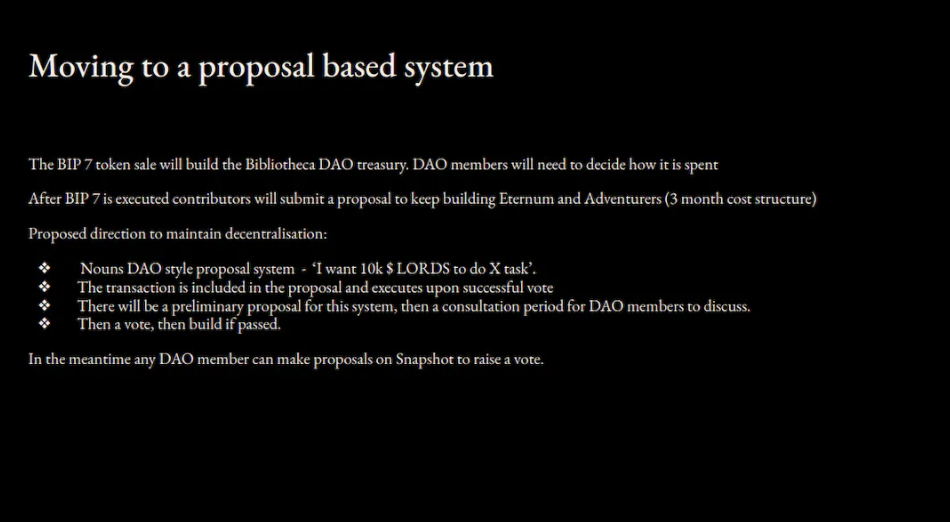
After the BIP7 proposal, Frontinus House officially began operations
Frontinus House will launch during the fundraising phase, during which builders will present the most innovative and compelling project ideas resonant with the vision, mission, and goals of Loot Realms.
The ultimate goal of Frontinus House is to cultivate a transparent, accountable, and collaborative culture in using public capital. It also aims to support the development of excellent public infrastructure that adapts to community needs. In doing so, RAW aims to achieve its vision of autonomy, promote transparency and collaboration within the Loot ecosystem, and provide necessary support for community-driven projects and infrastructure development.
Empowering Realmpire: Overview of Realms Grant Projects
With Frontinus House ready, the first round of Realm grant applications has begun. The 24 thoughtful proposals received for the Loot Realm Genesis Grant in the recent period demonstrate a revived interest and engagement within the Lootverse ecosystem, marking its recovery from a stagnant past year. During the passionate period following the release of Loot, nearly 300 derivative projects entered the stage, mainly focused on cultural and creative projects, collectively forming Lootverse. However, by mid-2022, only about 30 projects primarily focused on cultural and creative pursuits successfully survived the initial enthusiasm.
After another year, only 5 of these 30 projects are still active, reflecting a decline in momentum. However, with the introduction of the Dojo game engine on Starknet, a significant shift has occurred. This engine has lowered barriers for developers, opening the door to a new wave of projects, especially in the gaming and interactive experience fields. As a result of this shift, a new vitality has emerged, and now 24 new proposals have passed the Realm Grant. This new wave of projects is mainly related to games, leading to a resurgence of activity in the Lootverse, increasing the number of currently active projects to about 30. From 300 creative projects to 30 cultural survivors, and then to only 5 active initiatives, and now back to a diverse 30 projects, this fully reflects the dynamic journey of the Lootverse ecosystem.
The renewed vitality and transformation of game-related projects are closely related to the rise of the Dojo game engine on Starknet. By providing a powerful and user-friendly platform for game developers, Dojo has sparked a creative landscape within Lootverse. Combined with the organic momentum of Lootverse, it heralds a welcome spring after the crypto winter.
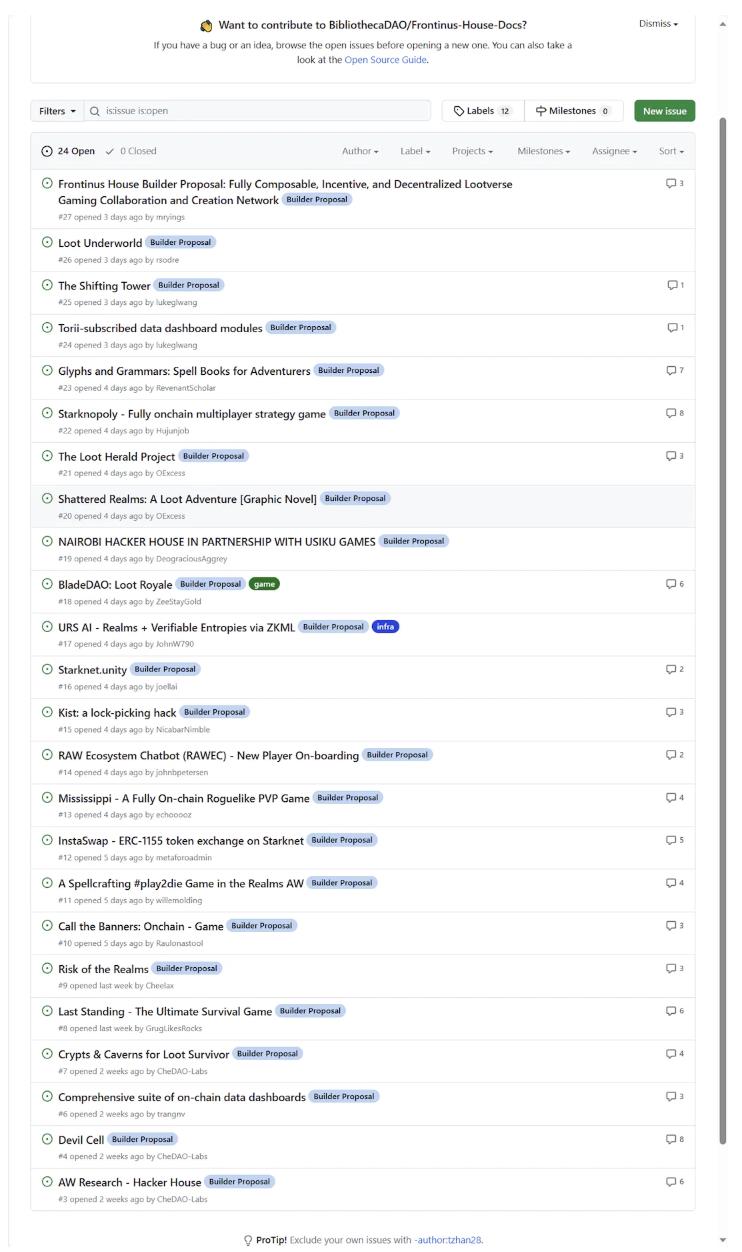
24 projects in the Realm Grant Applications
In the past year, the resilience displayed by Lootverse through its ups and downs highlights its deeply rooted nature. With this revived vitality and strengthened foundation, Lootverse is ready to move into the next phase of decentralized world-building, showcasing the vibrancy of a collaborative ecosystem built on open infrastructure (Loot).
Recent news confirms the formal approval of the BIP-14 proposal. The number of eligible grants has increased from 5 to 10, indicating a considerable level of confidence within the Realms community in promoting the ecosystem.
BIP-14: Increase Frontinus House Proposal 1 Grants to 10
Why to be bullish on Lootverse and Dojo Game Engine
Lootverse has nurtured a vibrant ecosystem through the combinability and interoperability of its core NFT elements. Projects like Realms, Loot, Genesis Adventurers, and Crypts & Caverns have established reusable building blocks, making collaborative world-building seamless. This modular approach reduces barriers for developers and creators to participate. By covering shared infrastructure such as maps, items, and characters, Lootverse empowers limitless imagination.
On the narrative level, Lootverse demonstrates the potential of decentralized storytelling. Through narrative techniques that inspire creativity, the community has collectively built a complex world. This decentralized model resists integration under a single vision and instead fosters diverse viewpoints. Lootverse showcases how blockchain achieves a permanent, open story shaped by collaborative participation.
As a complement to the rich world-building assets, Dojo provides a strong technical foundation as a game engine tailored for blockchain capabilities. Dojo's architecture is based on recursive proofs, incremental verification, and compressed state storage, opening up new frontiers in on-chain gaming. Combined with Cairo's performance, generality, and Rust-like advantages, Dojo has established a development environment that can unlock gameplay complexity far beyond current limitations.
With strong foundational components on the narrative, economic, and technical levels, Lootverse and Dojo have tremendous potential. As interoperable building modules accumulate and tools mature, their momentum becomes unstoppable. We are witnessing the birth of a new creative paradigm that will reshape the way collaborative digital worlds are built. When imagination and innovation converge, the possibilities are endless.
Lootverse and Dojo have laid the foundation for driving the next generation of community-driven game universes. As spectacular things unfold, it is clear that this is just the beginning.
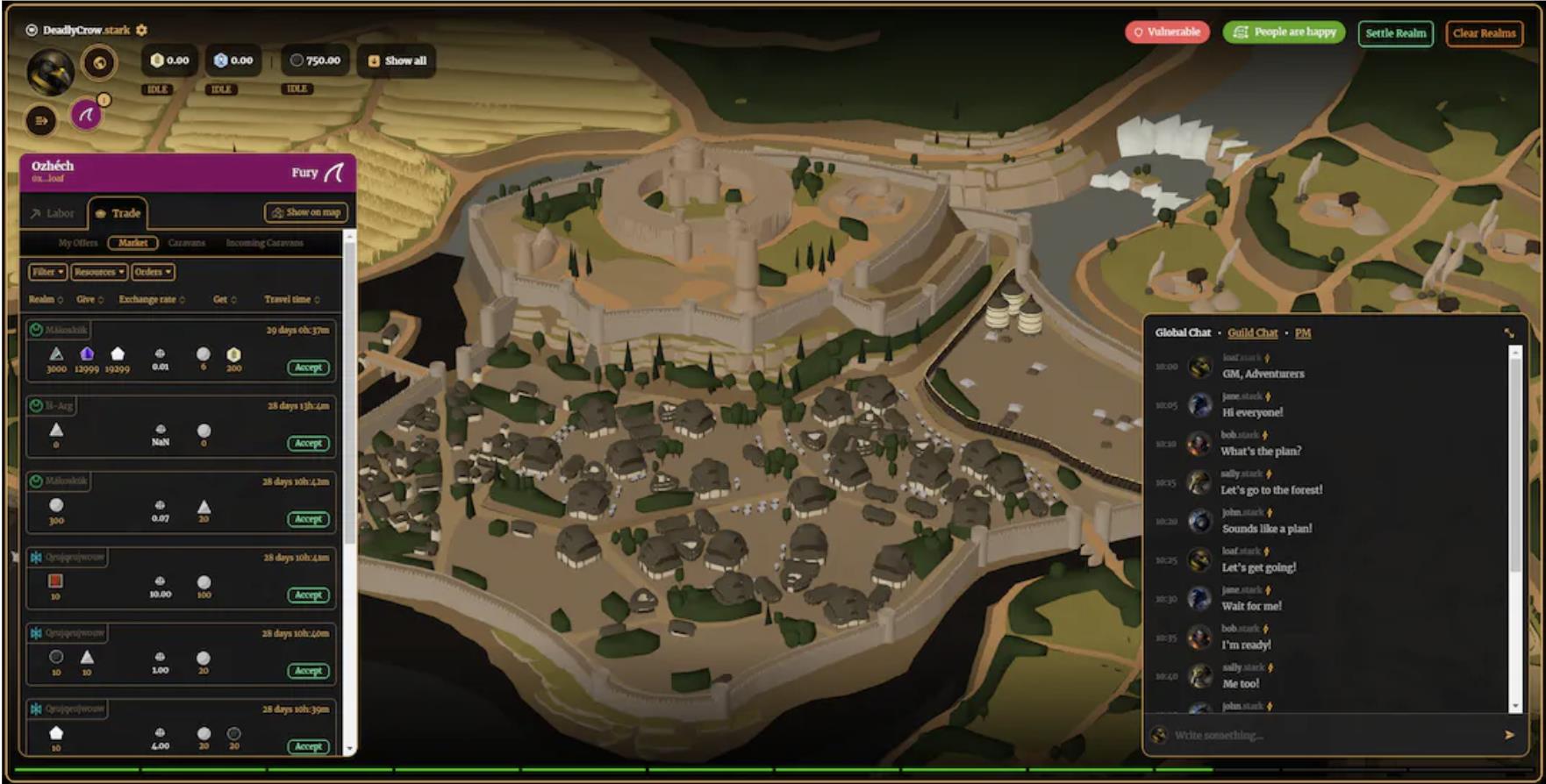
Role of Asian Developers and Why the Asian Community is Bullish
Lootverse offers a reminiscent of popular Asian game themes, such as the Three Kingdoms-themed fantasy sandbox. In China, Three Kingdoms games occupy nearly 10% of the gaming market, covering various genres from role-playing games to multiplayer online battle arena (MOBA) games. "Honor of Kings," the world's highest-grossing game, even features over 20% of characters from the Three Kingdoms period.
The cultural resonance of the Three Kingdoms across Asia can be reflected in the global appeal of Lootverse. As Lootverse expands, Asian developers, especially Chinese developers, can replicate the mature formula of Three Kingdoms games. With strong productivity and successful templates, Asian teams are expected to launch related Lootverse games and potentially capture over 10% of the on-chain gaming market share, potentially reaching the popularity of blockbuster games like "Honor of Kings."
Their familiarity with the broad appeal of story-based game universes will be invaluable. Seeing the thriving ecosystem in Asia, global creators will be drawn to participate in Lootverse. Their collaborative contributions in technology, content, and operations will complement each other to restore the original decentralized spirit of Lootverse.
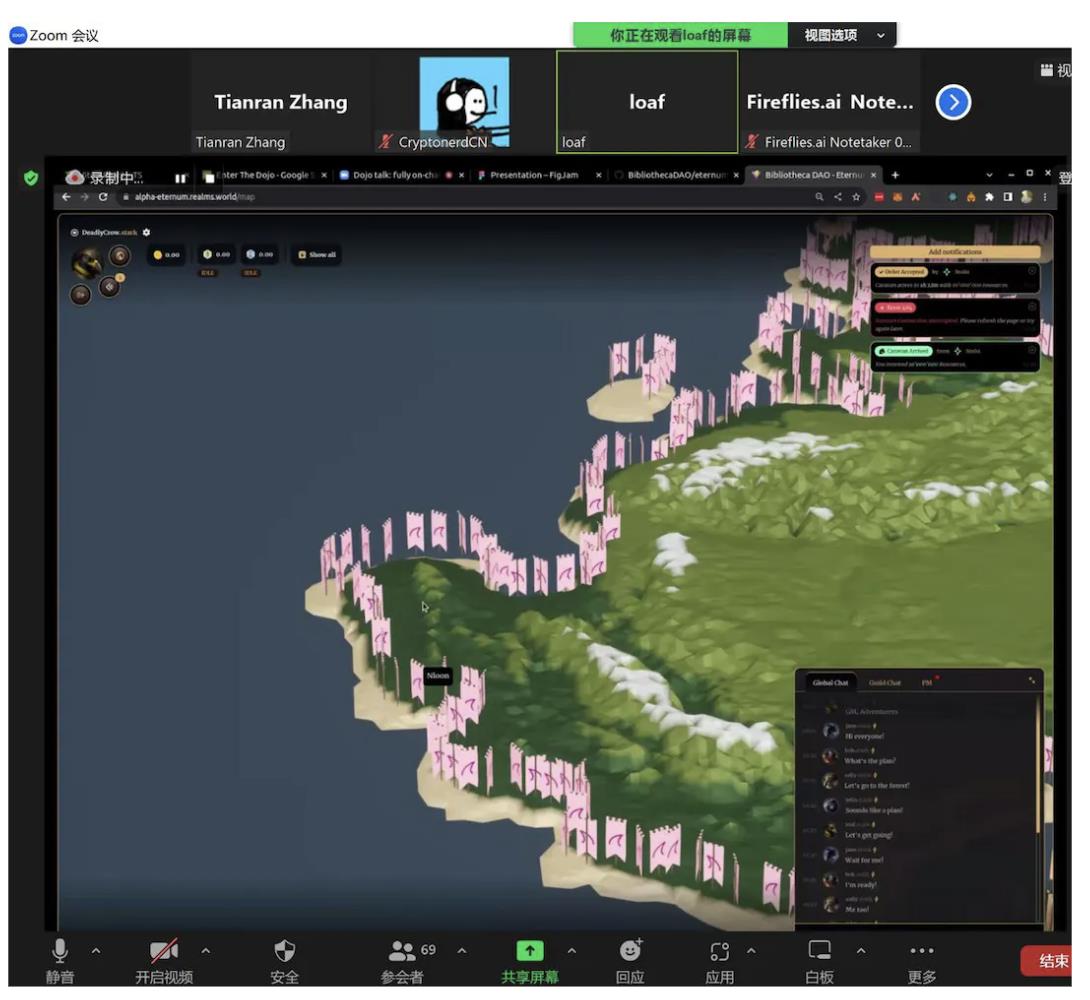
Screenshot of the demonstration at the Starknet Astro Workshop held in Chengdu by Loaf. The event once reached 100 participants.
With its narrative resonance and combinable fundamental elements, Lootverse could become the next breakthrough game paradigm driven by the Asian developer community. Their expertise plays a crucial role in guiding Lootverse towards true decentralization and diversity. By connecting global creators, Asian teams bring us closer to a metaverse-scale collaborative narrative.
免责声明:本文章仅代表作者个人观点,不代表本平台的立场和观点。本文章仅供信息分享,不构成对任何人的任何投资建议。用户与作者之间的任何争议,与本平台无关。如网页中刊载的文章或图片涉及侵权,请提供相关的权利证明和身份证明发送邮件到support@aicoin.com,本平台相关工作人员将会进行核查。




